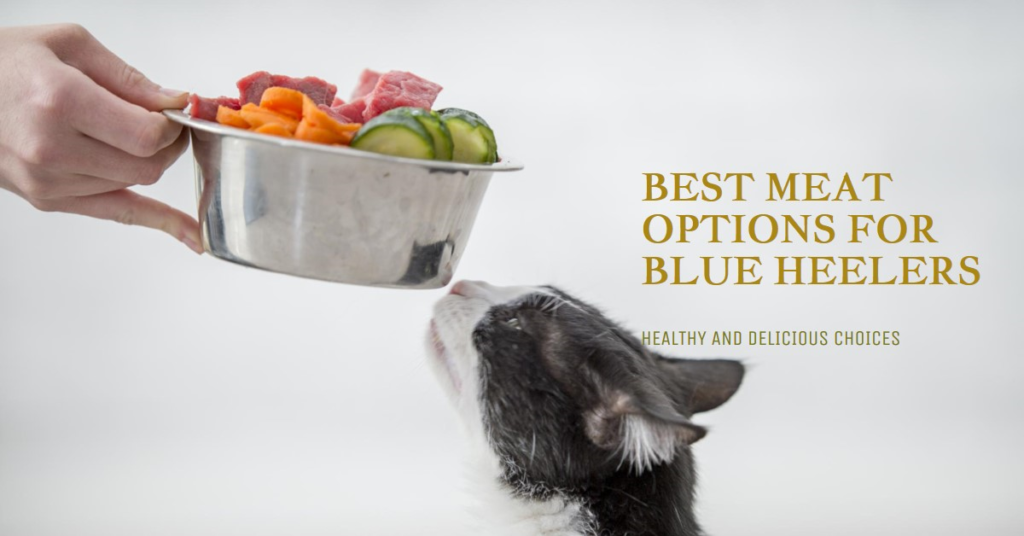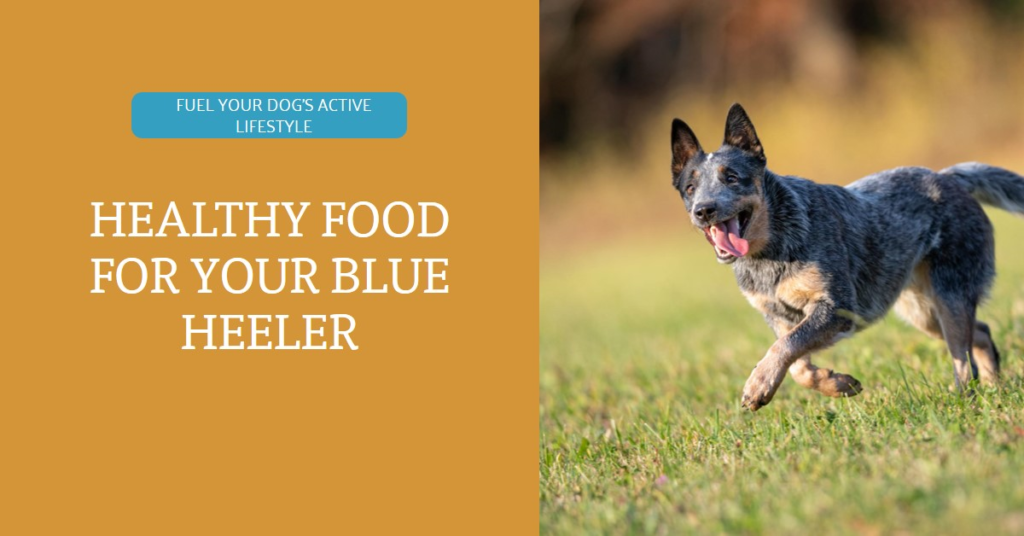The Blue Heeler is a popular herding breed of dog that originates from Australia. Also known as the Australian Cattle Dog, these pups are working dogs with strong instincts and high energy levels.
Their intelligence and stamina make them perfect farm companions, but they also need special care and certain foods to keep them healthy and active. They need good food to have lots of energy. In this article, we will talk about some good dog food for blue heelers. We will learn about different types of foods and what foods are best for blue heelers.
What to look for Blue Heelers in dog food
Good dog food for blue heelers should have meat as the first ingredient. Meat gives dogs lots of protein to keep their muscles strong. It should also have vitamins and minerals. This helps dogs stay healthy. Dog food should not have too many grains. Grains are hard for dogs to digest. The pieces of food should be small so blue heelers can eat them easily. Big pieces can hurt their mouth.
Best meat options for blue heelers

Chicken, beef, and lamb are really good meats for blueheelers. These meats give dogs protein without being too fatty. Chicken is easy to chew and digest. Blue heelers have lots of energy and need protein to keep their muscles working. Beef and lamb are slightly more fatty than chicken but give good energy. Fish like salmon is also a good option for protein.
Other ingredients to look for in Blue Heeler Dog food

As well as meat, look for foods with vegetables and fruits. Carrots, peas, and apples are easy for dogs to digest and give vitamins. Foods with whole grains, like brown rice, are better than wheat or corn. Whole grains have more nutrients. Foods should also have healthy fats from things like salmon oil. Fats give energy and keep skin and fur shiny. Look for foods that say ‘no artificial colors, flavors or preservatives.’ These can be bad for dogs.
Some Crucial Food Tips for Blue Heelers
Below, we have mentioned some of the crucial food tips for blue heeler dogs:
Feeding amounts for blue heelers
Blue healers are medium-sized dogs. Puppies need small meals 3-4 times a day. Adult blue heelers do best with two meals a day. The amount depends on their age and activity level. A good guide is 1-2 cups per meal for puppies and 1-1.5 cups for adults. It’s best to leave food down for 15-30 minutes and pick up any leftovers so they don’t eat too fast. Blue healers like to move around a lot, so that an active dog may need more food.
Making healthy treats
As well as their meals, blue healers like treats for training. Good treats include bits of lean meat, low-fat cheese, or vegetable sticks. Avoid very sugary treats which can hurt teeth. Make homemade treats by mixing peanut butter and oats or bananas and yogurt. Cut into shapes and wrap individually for training time—store extras in the fridge for up to a week. Check the date on store treats, and don’t use old ones.
Changing dog foods carefully
If switching dog foods for blue heelers, do it slowly over 5-7 days. Mix more of the new food daily while mixing in the old to let their tummy get used to the changes. Changing too fast can cause gas, diarrhea, or upset tummy. If you try new food that doesn’t agree, switch back or see a vet. Babies need simpler foods that are easy to chew. Avoid big, sudden changes when they are small. Only switch if required when they are still growing.
Dog food storage tips
Keep dog food for blue heelers in a sealed container in a dry, cool spot away from heat, sunlight, or pests. Plastic containers with tight lids work well. Store extra bags of kibble up high where mice or other animals can’t reach. Fold bags over tightly and place them in a bigger plastic tub. Check best before dates and use the oldest first. Throw out old food if bugs or mold appear as it’s no good. Clean storage place every few weeks.
What are the signs that your dog needs a diet change?
Pay attention to their mood, energy, and poops. If their stool is very loose often, they need extra bone or fiber in food. If it doesn’t taste good anymore, they could be bored. Try mixing in new flavors or toppers. Lethargic dogs may need more calories and protein. Overweight dogs need fewer treats and smaller meals. See a vet if weight loss, itchy skin, or other issues arise so diet can be adjusted properly for their needs. Check weight monthly and change food as they grow.
Homemade Vs. store-bought food
You can make homemade food for blue heelers, but it’s hard to know if they need everything. Store-bought food is better because companies add all the vitamins and minerals dogs need. Homemade food can be missing things. Some stores have freezers with fresh chicken, beef, and rice. These can be a good option instead of dry kibble. But kibble is easy to take on trips, so both have benefits.
Best store-bought foods
Royal Canin, Hill’s Science Diet, and Purina Pro Plan are some of the best store-bought foods. These foods have high-quality meat and limited grain. They are complete meals for blue heelers. For adult blue heelers, avoid puppy food. Puppies need more fat and calories to grow, but adult dogs don’t. Senior dog food is good for older blue heelers as they have added joint support vitamins.
Conclusion
Blue heelers need protein-rich foods with limited grains to keep them energetic. The best options are high-quality store-bought foods or homemade meals with lean meat and vegetables. This will help blue heelers stay happy and healthy for many long years playing. We can give our furry friends the nutrition they need to run and play all day by choosing the right food.
Frequently Asked Questions (FAQs)
My Blue Heeler is a very picky eater. Any tips?
Some Blue Heelers can be fussy eaters. Mix a little canned food, bone broth, or healthy toppers like peanut butter. Serving food in interactive toys also makes mealtime more fun. Don’t give in to begging – stick to scheduled feeding times. Consult your vet to rule out any medical issues. You can encourage your furry friend to develop healthy eating habits with patience and these tricks.
Can I feed my Blue Heeler table scraps sometimes?
In moderation, small amounts of people’s food as treats are okay. But they shouldn’t replace main meals. Too many carbohydrates or fatty foods can lead to weight gain or tummy trouble. Safer options are tiny bits of meat, cheese, or cooked veggies. Chocolate, onions, grapes, and other people’s foods can make dogs sick. Stick to their regular diet for most of their nutrition needs.
My blue heeler puppy has so much energy. What food is best?
Active Blue Heeler puppies need food to fuel their fun! Look for a large breed of puppy kibble that lists meat like chicken as the first ingredient. It should have around 22-26% protein to build strong muscles. Puppies also need extra fat and calories to grow. Feed them three small meals daily if they seem hungry. Be sure to leave some mealtime for mental/bonding exercises too!
What’s a good senior blue heeler dog food?
As Blue Heelers age, look for “senior” or “mature” formulations. They provide easier-to-digest carbs and proteins, senior-sized kibbles, plus extra joint support from glucosamine and vitamins C & E. Limited ingredients avoid stomach upset. Hill’s and Royal Canine’s senior lines are great options. Give seniors smaller, more frequent meals. Contact your vet if you notice decreased appetite, drinking, or changes in your aging best friend.
Also Read:


